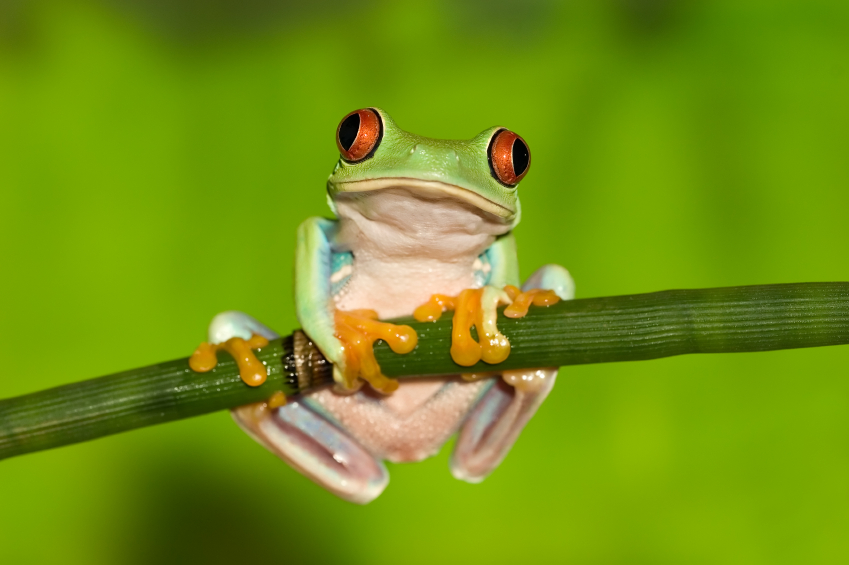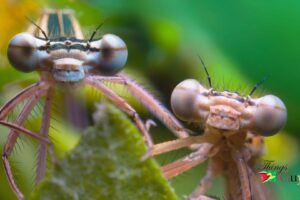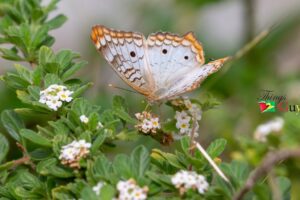The Red-Eyed Tree Frog (Agalychnis callidryas) is one charming tropical amphibian. With their bright red eyes, colorful sides, and an extremely expressive face, it’s hard not to be captivated by this wonderful frog.
It is commonly known as the “monkey frog” for its jumping abilities. It is relatively small measuring no more than eight centimeters.
The red-eyed tree frog lives about five years in the wild. They have sticky pads on their feet that allow them to stay balanced and in place.
Description Of The Red Eyed-Tree Frog
The body of the Red Eyed Tree Frog offers various colors. This includes green, yellow, blue, and orange. They have red eyes of course, and that is where their name comes from. They can be up to 2 inches for the males and up to 3 inches for the females. The young are brown in color and they will develop other colors as they get older.
The belly of the Red Eyed Tree Frog is soft, but the top of the body is very rough. They have very large eyes, and even though they only have two eyes they have three eyelids. They have long legs that are bright red in color, yellow or green. They use their eyes as a type of defense because most predators won’t come too close to them due to the appearance. The coloration of them will confuse the predator, giving the frog time to get away.
Habitat Of The Red-Eyed Tree Frog
They live in humid climates in trees near ponds and rivers in southern Mexico, Central America, and northern South America. They can also be found in Guyana dense rain forest. They occur from Veracruz and Oaxaca in Mexico to Panama and northern Columbia. The frogs have a relatively narrow temperature range requirement, so they only live in the rain forests and lowlands.
Diet Of The Red-Eyed Tree Frog
Tree frogs are carnivores that mainly hunt at night. They feed upon flies, crickets, grasshoppers, moths, and other insects. They have a very long tongue that they flick in and out to get them. They may spend long hours each night getting enough food. They serve a purpose of making sure there isn’t an abundance of insects in a given environment. They are also susceptible to fungal infections.
Behavior Of The Red-Tree Frog
The frog’s red eyes are used for a startle display called deimatic behavior. During the day, the frog camouflages itself by flattening its body against a leaf bottom so only its green back is exposed. If the frog is disturbed, it flashes its red eyes and reveals its colored flanks and feet. The coloring may surprise a predator long enough for the frog to escape. While some other tropical species are poisonous, camouflage and the startle display are the red-eyed tree frog’s only defense.
Tree frogs use vibration to communicate. Males quiver and shake leaves to mark territory and attract females.
Reproduction Of The Red-Eyed Tree Frog
Mating occurs from autumn to early spring, during the peak rainfall period. The males gather around a body of water and make a “chack” call to attract a mate. The egg-laying process is called amplexus. During amplexus, the female carries one or more males on her back. She draws water into her body to use to lay a clutch of around 40 gel-like eggs on a leaf overhanging water. The best-positioned male fertilizes the eggs externally.
If the eggs are not disturbed, they hatch within six to seven days, dropping the tadpoles into the water. However, red-eyed tree frog eggs exhibit a strategy called phenotypic plasticity, in which eggs hatch early if their survival is threatened.
8 Interesting Facts About The Red-Eyed Tree Frog
- Tree frogs have an extra eyelid that veils the eye without blocking sight.
- Clutches of red-eyed tree frog eggs hang exposed for 6 days.
- Tree frogs blink their big eyes when swallowing to force their prey down.
- Snakes and wasps steal more than half of all red-eyed tree frog eggs.
- If attacked, red-eyed tree frog embryos hatch within seconds.
- They have sticky pads on their toes to help them cling to surfaces.
- They’ve been around for millions of years. Frogs, in general, are a pretty old bunch. Fossils show that frogs have been around for hundreds of millions of years; red-eyed tree frogs specifically emerged roughly 10 million years ago.
- They’re somewhat poisonous. Tree frogs rely more heavily on their camouflage for protection, but they do have some toxins in their skin. This poison isn’t exactly dangerous, but it does leave a bad taste in some predators’ mouths. “I don’t think there’s animals that necessarily would die from eating them, but I think some species probably don’t eat them because they don’t taste the best,” Boyer says.
The Red-Eyed Tree Frog
It is one of the most magnificent frog that is commonly referred to as “monkey frog” because of its jumping abilities. It is a tropical amphibian that lives in lowland and rainforest. They eat almost anything that can fit in their mouths, some of which includes: Moths, crickets and other insects. The red-eyed tree frog is truly an extraordinary creature.
Article References:
- https://www.thoughtco.com/red-eyed-tree-frog-facts-4580231
- http://mentalfloss.com/article/63622/11-colorful-facts-about-red-eyed-tree-frog
- http://www.redeyedtreefrog.org/interesting-red-eyed-tree-frog-facts/
- https://www.nationalgeographic.com/animals/amphibians/r/red-eyed-tree-frog/
- https://www.bioexpedition.com/red-eyed-tree-frogs
- https://www.kaieteurnewsonline.com/2012/06/03/the-red-eyed-tree-frog-litoria-chloris-2/







